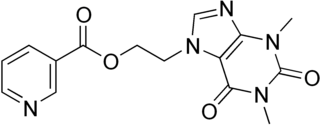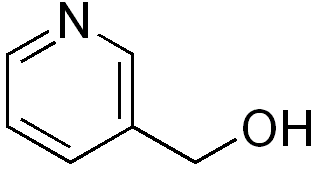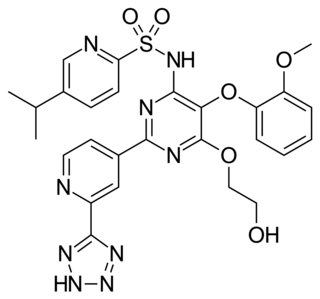 W
WAbnormal cannabidiol (Abn-CBD) is a synthetic regioisomer of cannabidiol, which unlike most other cannabinoids produces vasodilator effects, lowers blood pressure, and induces cell migration, cell proliferation and mitogen-activated protein kinase activation in microglia, but without producing any psychoactive effects.
 W
WAdenosine is an organic compound that occurs widely in nature in the form of diverse derivatives. The molecule consists of an adenine attached to a ribose via a β-N9-glycosidic bond. Adenosine is one of four nucleoside building blocks to RNA, which is essential for all life. Its derivatives include the energy carriers adenosine mono-, di-, and triphosphate. Cyclic adenosine monophosphate (cAMP) is pervasive in signal transduction. Adenosyl (Ad) is the radical formed by removal of the 5′-hydroxy (OH) group. Ad is found in vitamin B12 and the radical SAM enzymes. Adenosine is also used as a medication.
 W
WAmrinone, also known as inamrinone, and sold as Inocor, is a pyridine phosphodiesterase 3 inhibitor. It is a drug that may improve the prognosis in patients with congestive heart failure. Amrinone has been shown to increase the contractions initiated in the heart by high gain calcium induced calcium release (CICR). The positive inotropic effect of amrinone is mediated by the selective enhancement of high gain CICR which contributes to the contraction of myocytes by phosphorylation through cAMP dependent protein kinase A (PKA) and Ca2+ calmodulin kinase pathways.
 W
WAmyl nitrite is a chemical compound with the formula C5H11ONO. A variety of isomers are known, but they all feature an amyl group attached to the nitrite functional group. The alkyl group is unreactive and the chemical and biological properties are mainly due to the nitrite group. Like other alkyl nitrites, amyl nitrite is bioactive in mammals, being a vasodilator, which is the basis of its use as a prescription medicine. As an inhalant, it also has a psychoactive effect, which has led to its recreational use with its smell being described as that of old socks or dirty feet. It is also referred to as banapple gas.
 W
WBamethan is a vasodilator.
 W
WBenziodarone is a vasodilator.
 W
WBetahistine, sold under the brand name Serc among others, is an anti-vertigo medication. It is commonly prescribed for balance disorders or to alleviate vertigo symptoms, e.g. those associated with Ménière's disease. It was first registered in Europe in 1970 for the treatment of Ménière's disease.
 W
WBuflomedil is a vasoactive drug used to treat claudication or the symptoms of peripheral arterial disease. It is currently not approved by the Food and Drug Administration (FDA) for use in the United States. Currently available as trade name tablet Loftyl
 W
WButalamine is a vasodilator.
 W
WCarbocromen (chromonar) is a vasodilator.
 W
WCarpronium chloride (INN) is a hair growth reagent with a vasodilatory action.
 W
WCilostazol, sold under the brand name Pletal among others, is a medication used to help the symptoms of intermittent claudication in peripheral vascular disease. If no improvement is seen after 3 months, stopping the medication is reasonable. It may also be used to prevent stroke. It is taken by mouth.
 W
WCinaciguat is an experimental drug for the treatment of acute decompensated heart failure.
 W
WCinepazet is a vasodilator and is an ethyl ester derivative of cinepazic acid.
 W
WCloridarol is a vasodilator.
 W
WCromakalim (INN) is a potassium channel-opening vasodilator. The active isomer is levcromakalim. It acts on ATP-sensitive potassium channels and so causes membrane hyperpolarization. It can be used to treat hypertension as it will relax vascular smooth muscle to lower blood pressure. Hyperpolarisation of smooth muscle cell membranes pulls their membrane potential away from the threshold, so making it more difficult to excite them and thereby cause relaxation.
 W
WDiazoxide, sold under the brand name Proglycem, is a medication used to treat low blood sugar due to a number of specific causes. This includes islet cell tumors that cannot be removed and leucine sensitivity. It can also be used in refractory cases of sulfonylurea toxicity. It is generally taken by mouth.
 W
WDihydroergocristine is an ergot alkaloid. Alongside dihydroergocornine and dihydroergocryptine, it is one of the components of ergoloid mesylates.
 W
WDilazep is a vasodilator that acts as an adenosine reuptake inhibitor.
 W
WEfloxate is a vasodilator.
 W
WEtafenone is a vasodilator.
 W
WEtofylline nicotinate is a vasodilator.
 W
WFlosequinan is a quinolone vasodilator that was discovered and developed by Boots UK and was sold for about a year under the trade name Manoplax. It had been approved in 1992 in the US and UK to treat people with heart failure who could not tolerate ACE inhibitors or digitalis.
 W
WHeptaminol is an amino alcohol which is classified as a cardiac stimulant. It also increases coronary blood flow along with mild peripheral vasoconstriction. It is sometimes used in the treatment of low blood pressure, particularly orthostatic hypotension as it is a potent positive inotrope.
 W
WHexobendine is a vasodilator that acts as an adenosine reuptake inhibitor.
 W
WHistamine is an organic nitrogenous compound involved in local immune responses, as well as regulating physiological function in the gut and acting as a neurotransmitter for the brain, spinal cord, and uterus. Histamine is involved in the inflammatory response and has a central role as a mediator of itching. As part of an immune response to foreign pathogens, histamine is produced by basophils and by mast cells found in nearby connective tissues. Histamine increases the permeability of the capillaries to white blood cells and some proteins, to allow them to engage pathogens in the infected tissues. It consists of an imidazole ring attached to an ethylamine chain; under physiological conditions, the amino group of the side-chain is protonated.
 W
WImolamine is a coronary vasodilator which is used in the treatment of angina pectoris and as a local anesthetic.
 W
WInositol nicotinate, also called inositol hexanicotinate, is marketed in the United States as a "no-flush niacin" dietary supplement. Flushing, in physiology, essentially means that epidermal tissues have become reddened, such as when the skin is irritated from the histamine responses related to an allergic reaction, or from recent physical exercise, or even from anger or embarrassment. This form of niacin is supposed to reduce or prevent flushing by being broken down into the metabolites niacin and inositol at a slow rate.
 W
WIsoxsuprine is a drug used as a vasodilator in humans and equines. Isoxsuprine is a β2 adrenoreceptor agonist that causes direct relaxation of uterine and vascular smooth muscle via β2 receptors.
 W
WItramin tosilate is a vasodilator.
 W
WLinsidomine is a vasodilator. It is a metabolite of the antianginal drug molsidomine and acts by releasing NO from the endothelial cells nonenzymatically. It also hyperpolarizes the cell membrane through influencing the sodium-potassium pump and thereby rendering it less responsive to adrenergic stimulation. Linsidomine injection at a dose of 1 mg produces usable erection in about 70% of patients and full erection in up to 50% of patients. Linsidomine does not appear to be associated with priapism.
 W
WMilrinone, commonly known and marketed under the brand name Primacor, is a pulmonary vasodilator used in patients who have heart failure. It is a phosphodiesterase 3 inhibitor that works to increase the heart's contractility and decrease pulmonary vascular resistance. Milrinone also works to vasodilate which helps alleviate increased pressures (afterload) on the heart, thus improving its pumping action. While it has been used in people with heart failure for many years, studies suggest that milrinone may exhibit some negative side effects that have caused some debate about its use clinically.
 W
WMinoxidil is a medication used for the treatment of high blood pressure and male-pattern hair loss. It is an antihypertensive vasodilator. It is available as a generic medication by prescription in oral tablet form and over the counter as a topical liquid or foam.
 W
WMolsidomine is an orally active, long acting vasodilating drug used to treat angina pectoris. Molsidomine is metabolized in the liver to the active metabolite linsidomine. Linsidomine is an unstable compound that releases nitric oxide (NO) upon decay as the actual vasodilating compound.
 W
WNaftidrofuryl (INN), also known as nafronyl or as the oxalate salt naftidrofuryl oxalate or nafronyl oxalate, is a vasodilator used in the management of peripheral and cerebral vascular disorders. It is also claimed to enhance cellular oxidative capacity. The drug act as a selective antagonist of 5-HT2 receptors (with action as an inverse agonist of the 5-HT2A receptor specifically characterized). Naftidrofuryl is also licensed for the treatment of intermittent claudication due to peripheral arterial disease.
 W
WNicorandil is a vasodilatory drug used to treat angina.
 W
WNicotinyl alcohol (pyridylcarbinol) is a niacin derivative used as a hypolipidemic agent and as a vasodilator. It causes flushing and may decrease blood pressure.
 W
WA nitrovasodilator is a pharmaceutical agent that causes vasodilation by donation of nitric oxide (NO), and is mostly used for the treatment and prevention of angina pectoris.
 W
WOxyfedrine is a vasodilator and a β adrenoreceptor agonist. It was found to depress the tonicity of coronary vessels, improve myocardial metabolism and also exert a positive chronotropic and inotropic effects, thereby not precipitating angina pectoris. The latter property is particularly important, because other vasodilators used in angina may be counter productive causing coronary steal phenomenon.
 W
WPapaverine is an opium alkaloid antispasmodic drug, used primarily in the treatment of visceral spasm and vasospasm, and occasionally in the treatment of erectile dysfunction. It is used in the treatment of acute mesenteric ischemia. While it is found in the opium poppy, papaverine differs in both structure and pharmacological action from the analgesic morphine-like compounds.
 W
WPentifylline is a vasodilator.
 W
WPentoxifylline, also known as oxpentifylline, is a xanthine derivative used as a drug to treat muscle pain in people with peripheral artery disease. It is generic and sold under many brand names worldwide.
 W
WPhentolamine, sold under the brand name Regitine among others, is a reversible nonselective α-adrenergic antagonist.
 W
WPimobendan is a veterinary medication. It is a calcium sensitizer and a selective inhibitor of phosphodiesterase 3 (PDE3) with positive inotropic and vasodilator effects.
 W
WPrazosin is a medication primarily used to treat high blood pressure, symptoms of an enlarged prostate, and posttraumatic stress disorder (PTSD). It is a less preferred treatment of high blood pressure. Other uses may include heart failure and Raynaud syndrome. It is taken by mouth.
 W
WPrenylamine (Segontin) is a calcium channel blocker of the amphetamine chemical class which was used as a vasodilator in the treatment of angina pectoris; it was introduced in the 1960s by German manufacturer Albert-Roussel pharma gmbh which was acquired by Hoechst AG in 1974 and which in turn became part of Sanofi Aventis in 2005.
 W
WQuazinone (Dozonone) is a cardiotonic and vasodilator drug which was developed and marketed in the 1980s for the treatment of heart disease. It acts as a selective PDE3 inhibitor. It is no longer available.
 W
WRegadenoson, sold under the brand name Lexiscan among others, is an A2A adenosine receptor agonist that is a coronary vasodilator that is commonly used in pharmacologic stress testing. It produces hyperemia quickly and maintains it for a duration that is useful for radionuclide myocardial perfusion imaging. The selective nature of the drug makes it preferable to other stress agents such as adenosine, which are less selective and therefore cause more side-effects.
 W
WRiociguat is a drug by Bayer that is a stimulator of soluble guanylate cyclase (sGC). It is used to treat two forms of pulmonary hypertension (PH): chronic thromboembolic pulmonary hypertension (CTEPH) and pulmonary arterial hypertension (PAH). Riociguat constitutes the first drug of the class of sGC stimulators.
 W
WSodium nitroprusside (SNP), sold under the brand name Nitropress among others, is a medication used to lower blood pressure. This may be done if the blood pressure is very high and resulting in symptoms, in certain types of heart failure, and during surgery to decrease bleeding. It is used by continuous injection into a vein. Onset is typically immediate and effects last for up to ten minutes.
 W
WTezosentan is a non-selective ETA and ETB receptor antagonist. It acts as a vasodilator and was designed as a therapy for patients with acute heart failure. Recent studies have shown however, that tezosentan does not improve dyspnea or reduce the risk of fatal or nonfatal cardiovascular events.
 W
WTolazoline is a non-selective competitive α-adrenergic receptor antagonist. It is a vasodilator that is used to treat spasms of peripheral blood vessels. It has also been used successfully as an antidote to reverse the severe peripheral vasoconstriction which can occur as a result of overdose with certain 5-HT2A agonist drugs such as 25I-NBOMe, DOB and Bromodragonfly.
 W
WTrapidil is a vasodilator and an antiplatelet drug. It also acts as an antagonist of platelet-derived growth factor.
 W
WVinburnine is a vasodilator. Vincamone is a vinca alkaloid and a metabolite of vincamine.
 W
WVinpocetine is a synthetic derivative of the vinca alkaloid vincamine. Vincamine is extracted from either the seeds of Voacanga africana or the leaves of Vinca minor.
 W
WVisnadine is a natural vasodilator. It was first isolated from bishop's weed, a plant indigenous to the Mediterranean region which has been used for centuries in Egypt as a spasmolytic.
 W
WXanthinol is a drug prepared from theophylline used as a vasodilator. It is most often used as the salt with niacin, known as xantinol nicotinate.
 W
WYohimbine, also known as quebrachine, is an indole alkaloid derived from the bark of the African tree Pausinystalia johimbe; also from the bark of the unrelated South American tree Aspidosperma quebracho-blanco. Yohimbine is an alpha-2 adrenergic antagonist, and has been used in a variety of research projects. It is a veterinary drug used to reverse sedation in dogs and deer.